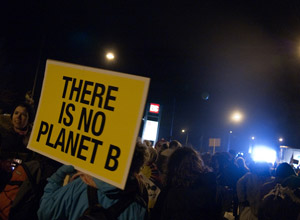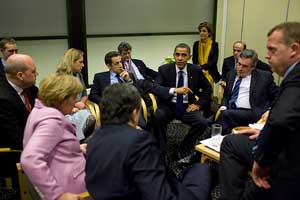
Image by Flickr user bjaglin
This is the first part of a two-part series by Bill McKibben, “Copenhangover: Rallying for Next Steps.” Read Part II here.
Depending on how you look at it, the Copenhagen climate talks ended either in ignominious failure, or vanilla failure, or just-about-but-not-quite-that-bad failure. The Swedes: a “disaster.” UK leader Gordon Brown: “at best flawed, at worst chaotic.” The financial markets, when they opened the following Monday, sent clean-tech stocks plummeting. You can judge the extent of the debacle by the quick attempts to deflect blame: “British Minister Blames China for Opposing Copenhagen Deal,” the Times of India reported. “China Rejects Blame for Copenhagen Failure,” responded the New Statesman a few days later. “EU Blames Others for ‘Great Failure’ On Climate,” the New York Times noted. In the days following the conference’s end (delegates were shooed out of the vast convention center to make way for a design show), a few inside-the-Beltway environmentalists insisted it had been a success after all, because at least China and the US were talking, or because it paved the way for something to happen in the Senate, or because whatever. But the president himself, speaking a few days after his return from the Danish capital, seemed more able to deal with reality: “I think that people are justified in being disappointed about the outcome in Copenhagen,” he told PBS. “At least we kind of held ground and there wasn’t too much backsliding from where we were.”
The failure might be defined this way: The world came together and looked climate change fairly straight in the eye, and then its most powerful nations blinked.
Civil society did a remarkable job forcing that stare-down—it managed to make an atmospheric carbon target of 350 parts per million the synonym for seriousness. (I helped organize one such effort at 350.org). One hundred and twelve nations endorsed that target during the Copenhagen meeting—but not the US and not China. Both had severe political constraints: For Obama it was 60 votes in the Senate and the power of the fossil fuel lobby; for Beijing, hundreds of millions of poor people looking for the easiest way out of their poverty. Both, for now, chose political realism over scientific realism; neither were willing to bet their futures on a dramatic transition away from coal and oil.
And so the climate change movement—arguably now the most widespread global movement ever—needs to figure out what comes next. Copenhagen has passed, and with it what seemed the perfect moment to take bold action. How now to build pressure, how now to force change?
In some ways, it’s too early to say for sure, especially since we don’t know how the minimalist accord Obama negotiated at the end of the conference will play out. There may be more international meetings this year, leading up to another Conference of the Parties in Mexico City next December. But it’s hard to imagine it turning into the same kind of spectacle. Meanwhile, green technology continues to spread—but by most accounts too slowly to alter the planet’s fate, barring a change in global policy that would accelerate the process. So there’s no rest in sight.
If any international accord is ever to succeed, American campaigners will have to make more progress within our own borders—the inability of the world’s greatest economic power to break with fossil fuel holds back every other nation. But that’s easier said than done—not only is the opposition fierce, but the American movement is fractured in powerful, perhaps dangerous ways. So here’s an early attempt to block out some of the action we can expect in the months ahead:
1) The Senate Bill
Known originally as Kerry-Boxer, and now Kerry-Boxer-Graham-Lieberman-and-whoever-else-might-be-the-60th-vote-and-hence-can-name-their-price, this is the “economy-wide cap-and-trade” bill that the administration has been working with its allies on Capitol Hill to craft since Obama took office. In its simplest form, it sets “caps” on the amount of carbon that utilities and the like can emit, and then allows them to trade those allowances, theoretically producing reductions in carbon emissions at the lowest possible cost. It’s modeled on legislation that helped reduce sulfur and nitrogen pollution from power plants over the last few decades; the Europeans have tried a similar system with mixed results to meet their Kyoto targets; and there are regional attempts at such a scheme in the US already, most notably in the northeast.
The bill is embraced by most of the big national green groups, either because they really like the cap-and-trade idea, or because they see it as the most politically realistic approach—that is, they think it can “count to 60.” Its initial targets are feeble—by 2020 America would have cut its emissions only 7 percent below 1990 levels, even as scientists say 40 percent would be more appropriate. But, writes Joe Romm, the indefatigable climate blogger who works for the very administration-connected Center for American Progress, it still would “create the institutions and the technology deployment capability so that come 2020ish, if the world gets appropriately desperate, we can act appropriately desperately.”
Romm predicts that Congress will be able to pass some version of the cap-and-trade bill—in the wake of Copenhagen he wrote, “I am more confident than ever we will see a serious economy-wide climate and clean energy bill pass in 2010″—if, that is, the president gets actively involved. Once such a bill passes, he says, China will be on the spot: “They’ve been behind a wall for a long time, and they haven’t had to demonstrate leadership to maintain credibility.” And over time, what seems controversial now will seem inevitable. “If Obama wins a second term, there won’t be a Republican coming in till 2017, and by then global warming will be painfully obvious. I have difficulty believing this bill will still be a contentious political issue.”
For the moment, though, it’s about as contentious as it gets, which is why not everyone is as convinced that a cap-and-trade bill will pass this year. As Sen. Joe Lieberman (I-Conn.) told the Washington Post‘s Juliet Eilperin, “I don’t think the Senate has an appetite for another such epic, polarized legislative war this session.” Especially one where the beneficiaries include the big bankers who would be figuring out how to trade carbon derivatives.
Which is why there’s suddenly a little more attention being paid to:
2) The Other Senate Bill
This one is short—about 40 pages to the 1,200 in the Kerry etc. omnibus—and in certain ways far more novel. Instead of starting by giving away pollution permits to the big utilities, it makes all the big fossil energy users pay a stiff price for the right to pour carbon into the atmosphere. And then it takes most of that money and uses it to send a check to every American every month, a kind of payment for their share of the sky. ExxonMobil would, of course, be passing on its new costs—the price of gas at the pump, or electricity at the meter, would go up. But the monthly check should cover most of that—indeed, lower income Americans, or those who are frugal with energy, should come out even or ahead. And the conceptual beauty of the plan is that it would make it politically easier to steadily tighten the cap on carbon as the science demanded it—every turn of the screw would mean not just a higher electric bill but also a larger monthly check. And Americans like getting checks, as Sarah Palin might attest—like every governor of Alaska, she distributed a share of oil revenues every year to the state’s residents.
This so-called ‘cap and dividend’ bill is the brainchild of Peter Barnes, founder of the progressive money-fund company Working Assets (now Credo Mobile), who considers it a Plan B should Kerry-Boxer-etc. fail. Because the bill would send 75 percent of proceeds straight back to taxpayers and has, if anything, weaker initial targets than Kerry-Boxer, it might have a chance of picking off some moderate Republicans—it was introduced in the Senate in December by Maria Cantwell (D-Wash.) and Susan Collins (R-Maine). Nobody seems to actively dislike the idea—even Romm says it would be a decent idea “if it were politically feasible.” But he thinks it’s not because it would put more of a burden on consumers in the Southeast and Midwest, plus utilities would fight it tooth and nail. Still Barnes insists that the White House has not actually shot the idea down. “The president has shown he’s a political pragmatist. He’ll get to 60 any way he can. If he can at all.”
3) The Technologists
Unlike other problems—racism, say—global warming is clearly, at least in part, a technological problem. Which means that many of the people looking at solutions find themselves backing one form of silver bullet or another. I get emails daily from exasperated people wondering why their favorite—biochar, biomass, high-altitude wind, community-scale wind, nuclear, concentrated solar, dispersed solar, tidal power, carbon farming, vegetarianism, grass-based pasturing—hasn’t become the agreed-upon fix. The answer is that no one thing can replace coal and gas and oil: Highly concentrated, easy to get at, simple to transport, they really are magic fuels. More than silver bullets, we’re likely to get silver buckshot—a mix of alternatives.
The basic theory behind cap-and-trade and cap-and-dividend is that the key to getting those alternatives in place is to increase the price of fossil fuel—solar and wind will naturally soar as oil gets more expensive, the way you would buy strawberries for your cereal if the price of bananas skyrocketed. But that assumes that solar energy is just like strawberries, just sitting there on the shelf. There are those who think politicians will never drive the cost of fossil fuel up enough to make renewables competitive—that we should spend our energy on funding basic research instead of capping carbon. “We’re techno-pessimists,” says Ted Nordhaus, the chairman of the Breakthrough Institute and one of the loudest proponents of this argument. “We don’t have good, scaleable, cheap substitutes for fossil fuels now,” he contends. The Germans, he says, are leading the world in installing rooftop solar reactors—because they’re paying what he estimates is the equivalent of $500 a ton to reduce carbon, “ten times what we’re talking about in Congress.”
More R&D spending (way more R&D spending—the Institute has used the figure $10.5 trillion-with-a-T as the minimum total cost of an energy transition, and thinks $30-50 billion a year is probably needed in research money) is therefore a chief priority. They’ve proposed a National Institute of Energy, much like the NIH; the Brookings Institution has talked about building Silicon Valley-like “energy innovation hubs” around the country. And as these new discoveries come to light, the government would have to drive demand by buying up the technology at a high enough price—much, Nordhaus contends, as the Defense Department did with semi-conductors.
Almost everyone agrees that more technology would help. But the technologists have often been scornful of political action to control carbon. (Thomas Friedman, in last year’s best-selling Hot, Flat, and Crowded, argues for deploying technology as the first priority by saying “a truly green America would be more valuable than fifty Kyoto Protocols.”) The trouble is, as Romm points out, to really bring global warming under control you also have to close existing coal-fired power plants. “And all the R&D in the world will not make clean energy cheaper than coal plants you’ve already built. You’ve got to have to have a rising price for CO2 and a shrinking cap.” Indeed, Nordhaus agrees that a “modest” carbon cap would help move new technologies the final mile toward deployment—but he thinks there’s a far longer voyage first, while the CO2-reduction-first crowd believes current technology could go a long way, given an economic tailwind.
Read Part II of this series here.












